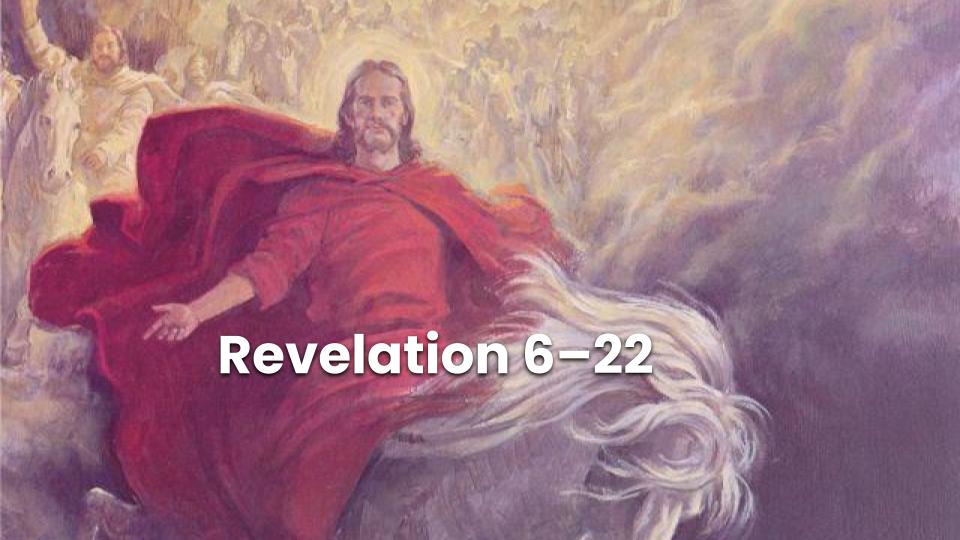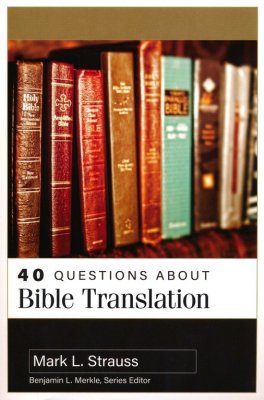Here are some ideas for learning and teaching a few of the great principles in Revelation 6-22. And while you’re here, I recommend you check out my free online course, “Seeking Jesus.”
Videos for Revelation 6-22
“The Battle of Armageddon” This is a short clip excerpted from “Seeking Jesus” that reminds us that while there’s a lot we don’t know about the end time battles, we do know the most important detail–Jesus wins.”
“What happens after the Second Coming?” This is a short clip excerpted from “Seeking Jesus” that shares powerful principles from Revelation 21-22 about what happens after the the Second Coming…including the detail that the Bible begins and ends with the tree of life.
The Bible Project videos are helpful for getting a big picture, you might enjoy their overview of Revelation (Part 1, Part 2).
Ideas for Learning and Teaching About Revelation 6-22
***The Battle of Armageddon: Jesus Wins***
Growing up, I heard about an epic battle called “The Battle of Armageddon,” that would take place just before the Second Coming. It was only later that I learned that the phrase “Battle of Armageddon” is not a scriptural phrase. In fact, the word “Armageddon” only appears one time in scripture. Revelation 16:16 says, “He gathered them together into a place called in the Hebrew tongue Armageddon.” This word Armageddon comes from the Hebrew phrase “Har-Megido” or the hill/mountain of Megiddo.
Megiddo was the scene of many different Old Testament wars. Old Testament leaders such as Joshua, Deborah and Josiah fought in major battles in this area. To the first century recipients of the Book of Revelation “Megiddo” might sound something like “Pearl Harbor” does today—a site associated with war.
Prophecies about final battles taking place before the Savior’s return are scattered throughout scripture and it’s hard to know exactly what will take place. It can be interesting to imagine what the end-of-days battles might look like, but I also think it’s important to remember that we only have a few verses on the warfare that will take place prior to Christ’s return, and they can be rather cryptic. Rather than focusing on which countries will be involved in end-times battles, I want to emphasize a consistent scriptural theme—Jesus wins.
The Book of Revelation describes battles in ways that are difficult to translate into modern times, but what I love most is how the battle ends. John portrays the final battle as easily being won by the Savior.
We read, “I saw heaven opened, and behold a white horse; and he that sat upon him was called Faithful and True, and in righteousness he doth judge and make war. His eyes were as a flame of fire, and on his head were many crowns…he was clothed with a vesture dipped in blood: and his name is called The Word of God” (Revelation 19:11-13).
Note that Christ’s clothing is dipped in blood before the battle begins. Perhaps this suggests that he has already been fighting for us—even before the battle. It may also remind us that Jesus is the Lamb who was slain from the foundation of the world.
Continuing in Revelation 19 we read, “And the armies which were in heaven followed him upon white horses, clothed in fine linen, white and clean. And out of his mouth goeth a sharp sword, that with it he should smite the nations: and he shall rule them with a rod of iron…” (Revelation 19:14-16).
Notice how in this battle, the only weapon mentioned is the sharp sword coming out of Christ’s mouth. One way you can look at this passage is that the word of Christ will win in the final conflict. The enemy has wild beasts, dragons, locusts and host of other weapons, but Christ’s word is victorious. Jesus rules with a rod of iron, which, if we connect it to 1 Nephi 11 also represents the word of God.
John is quite brief in his description of how the battle turns out. He writes, “I saw the beast, and the kings of the earth, and their armies, gathered together to make war against him that sat on the horse, and against his army. And the beast was taken, and with him the false prophet that wrought miracles before him, with which he deceived them that had received the mark of the beast, and them that worshipped his image. These both were cast alive into a lake of fire burning with brimstone. And the remnant were slain with the sword of him that sat upon the horse, which sword proceeded out of his mouth” (Revelation 19:19–21). In other words, Jesus wins.
Something striking about this account is that there is no actual battle. John introduces Armageddon in chapter 16, and he spends a lot of time describing how powerful the beast and dragon are. But ultimately, they are all talk and no walk. Satan has no power, and evil poses zero threat. Once Jesus shows up it’s over.
There have been some terrible battles in the previous centuries, and even worse warfare may lie in our future. But ultimately the evil forces in the world will be conquered by Christ. No matter how bad things get, we have peace when we remember that Jesus has won, is winning, and will win.
***Life After the Second Coming***
What happens after the Second Coming? John the Revelator gives us one picture.
He says, “I…saw the holy city, new Jerusalem, coming down from God out of heaven, prepared as a bride adorned for her husband. And I heard a great voice out of heaven saying, Behold, the tabernacle of God is with men, and he will dwell with them, and they shall be his people, and God himself shall be with them, and be their God. And God shall wipe away all tears from their eyes; and there shall be no more death, neither sorrow, nor crying, neither shall there be any more pain: for the former things are passed away. And he that sat upon the throne said, Behold, I make all things new” (Revelation 21:2–5).
What a beautiful place to live. John provides a series of details about the New Jerusalem that we might not seem meaningful to us, but would have been especially impressive to his first century listeners. Remember that Revelation was originally written to a first century audience. At that time, small towns like Capernaum or Nazareth did not have walls around them—they were too costly to build. In contrast, the greatest cities in the world had massive city walls. Ephesus, one of the cities to who Revelation is directed, had walls around the city that were about 5.5 miles in length. The mighty city of Rome had walls that were 7 miles in length, and as high as 33 feet in some places. Pretty impressive!
But John tells us that the walls around New Jerusalem are 6,000 miles in perimeter and 1,500 miles in height. In other words, they completely dwarf anything the people at that time could have imagined. Another interesting note about these walls—when Ezekiel had a vision of Jerusalem in the end-times, he described a city with walls of about 1.5 miles on each side. What John sees in nearly 1,000 times bigger than what Ezekiel foretold—perhaps symbolically indicating that God will not only fulfill his promises, he will more than do so.
Small villages had dirt roads, Rome brought stone roads, but in the new Jerusalem, “the street of the city was pure gold” (Revelation 21:21).
Small villages had no running water, Rome brought water into the cities via aqueducts. But in the New Jerusalem there’s no need for aqueducts, because a fountain of living waters flows freely (see Rev. 21:6).
Roman cities (and even Jerusalem before it was destroyed) would have one or more temples as a dwelling place for a deity. But speaking of the New Jerusalem, John says, “I saw no temple therein: for the Lord God Almighty and the Lamb are the temple of it” (Revelation 21:22). In other words, the temple had been the place for God and people to meet, but in the New Jerusalem, it is not needed because Jesus Christ lives there among his people.
This city sounds incredible! What will it take to enter? Will there be a security check point? Do I need to bring my passport? No passport is required. But although the gate is wide open, not everyone can enter. John tells us, “The gates of [the New Jerusalem] shall not be shut…And there shall in no wise enter into it any thing that defileth, neither whatsoever worketh abomination, or maketh a lie: but they which are written in the Lamb’s book of life” (Revelation 21:25). The gates aren’t closed to keep people out, they are wide open, inviting followers of Christ to enter. We read that those who “do [Christ’s] commandments… have right to the tree of life, and may enter in through the gates into the city” (Revelation 22:14).
You and I know that the book of Revelation was not the last book of the Bible to be written. But for a moment, let’s consider the Bible as we have it. The second chapter of the Bible speaks of the tree of life—because of the fall, Adam and Eve could not partake of it. But here in the Bible’s final chapter we learn that “In the midst of the street of [the New Jerusalem]…was… the tree of life, which bare twelve manner of fruits, and yielded her fruit every month: and the leaves of the tree were for the healing of the nations” (Revelation 22:2).
The thing that was once forbidden and inaccessible to humankind is now completely available. And it’s available through Jesus Christ. This shows how the consequences of the fall are reversed through our Redeemer. Humans, once blocked from the tree of life can now return and partake of its fruit. The New Jerusalem is going to be a beautiful place. And you and I can live there one day—because of Jesus Christ.
The Savior lives. And he’s coming back. We don’t know when, but as we prepare for that blessed future day, we can see glimpses of our future joys today, right here, right now.
***Additional Resources***
Revelation and the End of All Things, is probably my favorite book on Revelation. It is written by Craig R. Koester, a Christian scholar. Dr. Koester has a “Great Course” on the Book of Revelation. Although lacking in additional insights provided by the Restoration, there are lots of great nuggets in this book and course.
“The Book of Revelation with Nicholas J. Frederick,” A great podcast episode done by LDS Perspectives.
“Insights from the JST into the Book of Revelation,” by Gerald N. Lund
“Teaching the Book of Revelation: Five Considerations,” by Richard D. Draper
“Understanding Images and Symbols in the Book of Revelation,” by Richard D. Draper
Do you want more learning and teaching tips for Come Follow Me? Follow me on Instagram or sign up here for emails with insights on Come Follow Me.






